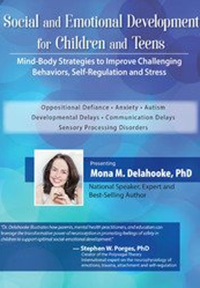Mona Delahooke – Social and Emotional Development for Children and Teens
Through clear, straightforward steps, guiding principles and mind-body techniques backed by neuroscience and research, Mona Delahooke, PhD, will teach you practical methods to better support the social and emotional lives of the children and families you work with.
Watch this cutting-edge seminar and you will learn valuable tools to nurture relationships, measure progress, reduce child stress, address challenging behaviors and promote self-regulation. Through case studies, video examples, and dynamic discussion you will learn how and when to use specific treatment techniques based on each child’s unique individual emotional, sensory/motor and developmental profile.
Discover how to customize treatment and educational strategies across disciplines through a mind/body and user-friendly roadmap of social and emotional development applicable to:
- Oppositional Defiance
- Challenging behaviors
- Anxiety
- Depression
- Autism
- Mental health issues
- Developmental delays
- Communication delays
- Sensory Processing disorders
Social and Emotional Development for Children and Teens workshop will show how to develop these skills in children and teens with clear, practical and attuned strategies to guide you to harness strength and hope in garnering psychological resilience for children and families.
Social and Emotional Development for Children and Teens Outline
Foundations for Social-Emotional Treatment
- Difference between developmental and chronological age and clinical/educational implications
- Neuroception—Polyvagal Theory (Stephen Porges, Ph.D.)
- The therapeutic “use of self”
- Difference between purposeful misbehavior and stress responses
- Parent-child and provider-parent relationships
- Promote a calm and alert state
Strategies Tailored to Individual Differences
- Conscious vs unconscious behaviors
- Identify underlying challenges
- Work at each person’s neurodevelopmental level
- Identify the behavioral features of stress responses and how to support in real time
- Treat functional capacities/challenges across diagnoses
- Three steps to personalized attunement
Mind-Based Techniques for Regulation, Attention and Engagement
- Sensorimotor contributions to physiological regulation
- Establish the neuroception of safety as the priority
- Auditory and other sensory pathways to support physiological and emotional regulation
- Play techniques for pre-symbolic development
- Powerful wordless dialogues
- Non-verbal social problem solving
Body-Based Techniques for Social Problem-Solving, Executive Function and Cognitive Flexibility
- Communicative flow
- Build symbolic bridges
- Re-enactment of procedural memories and how to debrief
- Availability to use “mind” to control body
- Integrate mind/body strategies
Techniques for Autism Spectrum Disorder
- Behavioral, developmental and hybrid approaches—how to choose
- Floortime®, DIR and FCD, and developmental, relationship-based techniques
- Behavioral and developmental techniques
- Alternative forms of communication for non-speakers
- Lessons about neurodiversity and avoiding ableism
Techniques for Communication Delays
- Non-verbal communication
- Affect/emotion harnessing techniques
- Promote intentional communication with caregiver
- How to combine words, affect and action
Techniques for Challenging Behaviors
- Deconstruct oppositional defiant disorder
- Determine upstream causes of challenging behaviors
- Use the child’s natural sensory preferences for cooperation
- Stress responses and faulty neuroception
- Support adaptive responses to emotional dysregulation
Techniques for Anxiety, Stress and Trauma
- Identify stress responses as early as possible
- Emotional co-regulation and modulation strategies
- Build symbolic pathways through story telling
- Explore fears through procedural re-enactment
- Partner with parents

